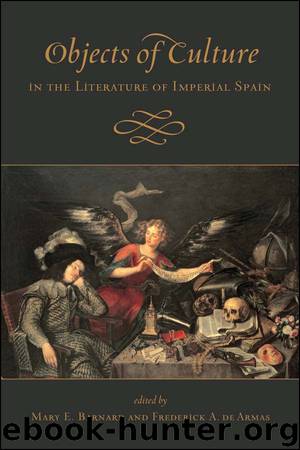Objects of Culture in the Literature of Imperial Spain by De Armas Frederick A.;Barnard Mary E.;

Author:De Armas, Frederick A.;Barnard, Mary E.; [Barnard, Mary E. and de Armas, Frederick A.]
Language: eng
Format: epub
Tags: LIT004280, ART015080, LIT000000
Publisher: University of Toronto Press
Published: 2013-02-26T16:00:00+00:00
NOTES
1 For a summary of the arguments on both sides, see the opening of Williamson’s essay, Friedman (1987, 238–9 n36), and Dunn (1993, 72–87).
2 See Friedman (1987, 236–7 n26) and Dunn (1993, 46–72) on approaches to Guzmán de Alfarache. Seminal in this regard is the work of Enrique Moreno Báez. See also, as starting points, the general studies of Alemán and the Guzmán by Donald McGrady and Ángel San Miguel.
3 On the “implied author” and related topics, see Booth, Chatman (1978, 146–95; and 1990, 74–108), Lanser (1981, 49–52, and 130–7), Rimmon-Kenan (1983, 86–9, and 100–5), Genette (1998, 135–54), Currie (1998, 19–29), and Lothe (2000, 11–27), and, for general considerations, Keen and the essays in van Peer and Chatman. In his study of lacunae in the picaresque, Parrack relates silence to the intervention of the implied author.
4 In important studies, Amelang gives nuanced readings of the social structure of Spain and of Europe in general.
5 On the dating of the Buscón, see, for example, Díaz-Migoyo (1980).
6 Frank Casa reads Lázaro as detached from the obsession with honour. For a different slant in the same journal, in a special number dedicated to Lazarillo de Tormes and guest-edited by Robert Fiore, see Friedman (1997).
7 The reference is to J.L. Austin’s book and to speech-act theory (1975).
8 The question of polisemia, especially as it relates to Lazarillo de Tormes, is a major concern of Francisco Rico in La novela picaresca y el punto de vista.
9 See Yovel for commentary on Alemán (2009, esp. 270–5) and for a comprehensive consideration of New Christian identity.
10 Parker (1967) uses the criterion of degree of delinquency to classify narratives as picaresque. Lazarillo de Tormes is, for Parker, a “precursor,” so his dating starts at 1599, with the publication of Guzmán de Alfarache. For a sense of current directions in picaresque studies, see Cruz (2008).
11 See Arias (1977), Brancaforte (1980), Whitenack (1985), and Rodríguez Matos (1985), who share the view that Guzmán is an unreliable narrator whose conversion is suspect. See also Shipley (1982), for an ingenious reading of Lázaro’s rhetorical strategies.
12 Ginés de Pasamonte famously alludes to Lazarillo de Tormes in Part 1, ch. 22, of his own version of Don Quijote.
13 Domínguez Castellano (2003) reads the Guzmán from this perspective.
14 Pablos’s metatheatrical feat – a form of independence from his author – is the thesis of Williamson’s essay (1977, 59).
15 The phrase forms the title, and topic, of a study of early modern English literature by Stephen Greenblatt (1980).
16 In his edition of the Quevedo’s Buscón, Domingo Ynduráin explains that it was said that the Antichrist would be born of a priest and a nun (1998, 289n372).
17 Pablos writes, “Pasábamoslo en la iglesia notablemente, porque, al olor de los retraídos, vinieron ninfas, desnudándose para vestirnos” [We spent our time at church because, remarkably, at the smell of poverty, nymphs came over and undressed themselves in order to clothe us] (1998, 306).
18 Among a number of examples, see the studies of Javier Herrero on the imagery of Lazarillo de Tormes (1978).
Download
This site does not store any files on its server. We only index and link to content provided by other sites. Please contact the content providers to delete copyright contents if any and email us, we'll remove relevant links or contents immediately.
The Secret History by Donna Tartt(18188)
Red Sparrow by Jason Matthews(5199)
Harry Potter 02 & The Chamber Of Secrets (Illustrated) by J.K. Rowling(3557)
In a Sunburned Country by Bill Bryson(3374)
Drawing Cutting Edge Anatomy by Christopher Hart(3293)
Figure Drawing for Artists by Steve Huston(3274)
Harry Potter and the Prisoner of Azkaban (Book 3) by J. K. Rowling(3116)
The Daily Stoic by Holiday Ryan & Hanselman Stephen(3112)
Japanese Design by Patricia J. Graham(3004)
The Roots of Romanticism (Second Edition) by Berlin Isaiah Hardy Henry Gray John(2822)
Make Comics Like the Pros by Greg Pak(2760)
Stacked Decks by The Rotenberg Collection(2692)
Harry Potter and the Deathly Hallows (7) by J.K. Rowling(2553)
Draw-A-Saurus by James Silvani(2509)
Tattoo Art by Doralba Picerno(2492)
On Photography by Susan Sontag(2489)
Foreign Devils on the Silk Road: The Search for the Lost Treasures of Central Asia by Peter Hopkirk(2389)
Churchill by Paul Johnson(2370)
The Daily Stoic by Ryan Holiday & Stephen Hanselman(2346)
